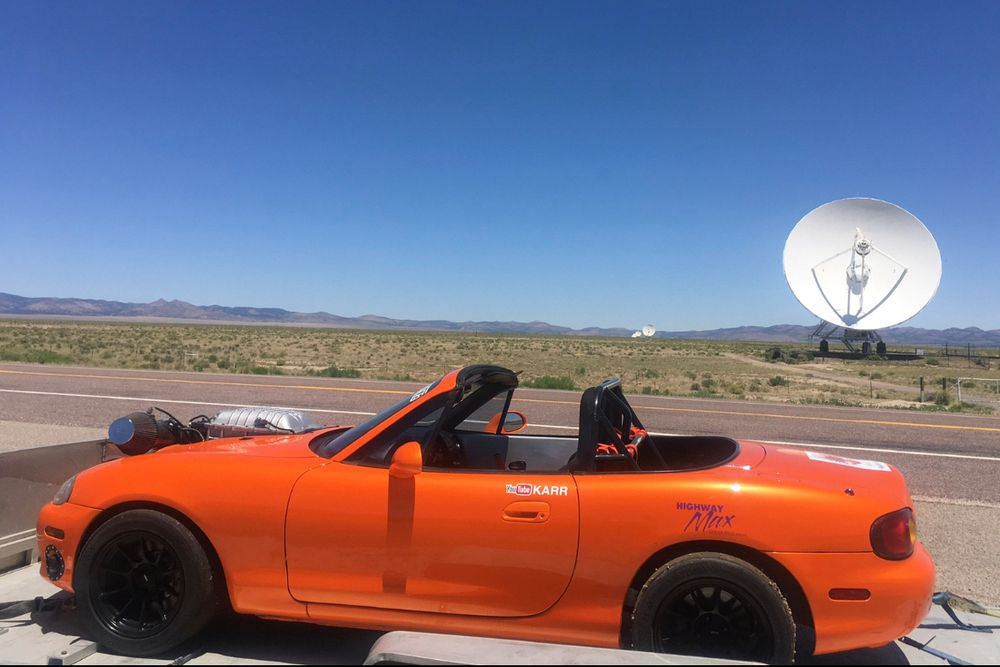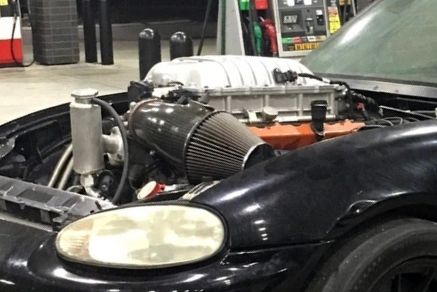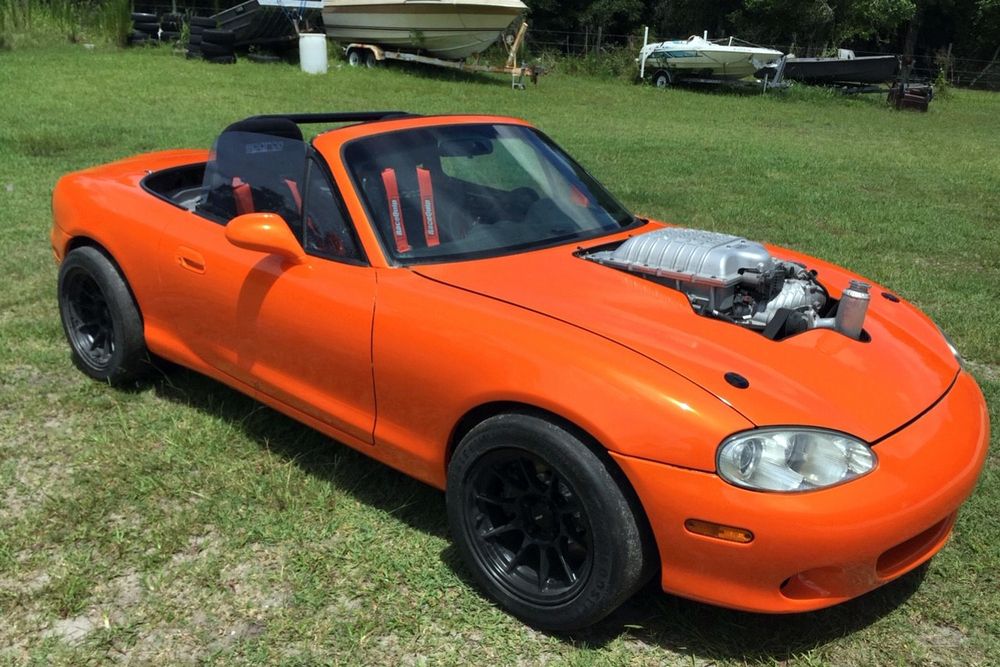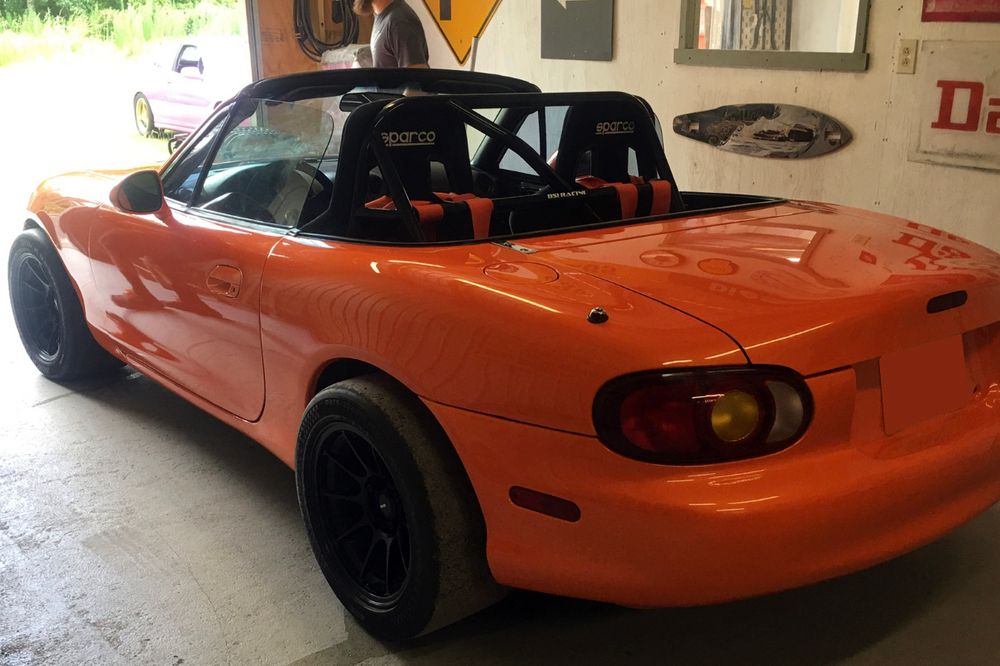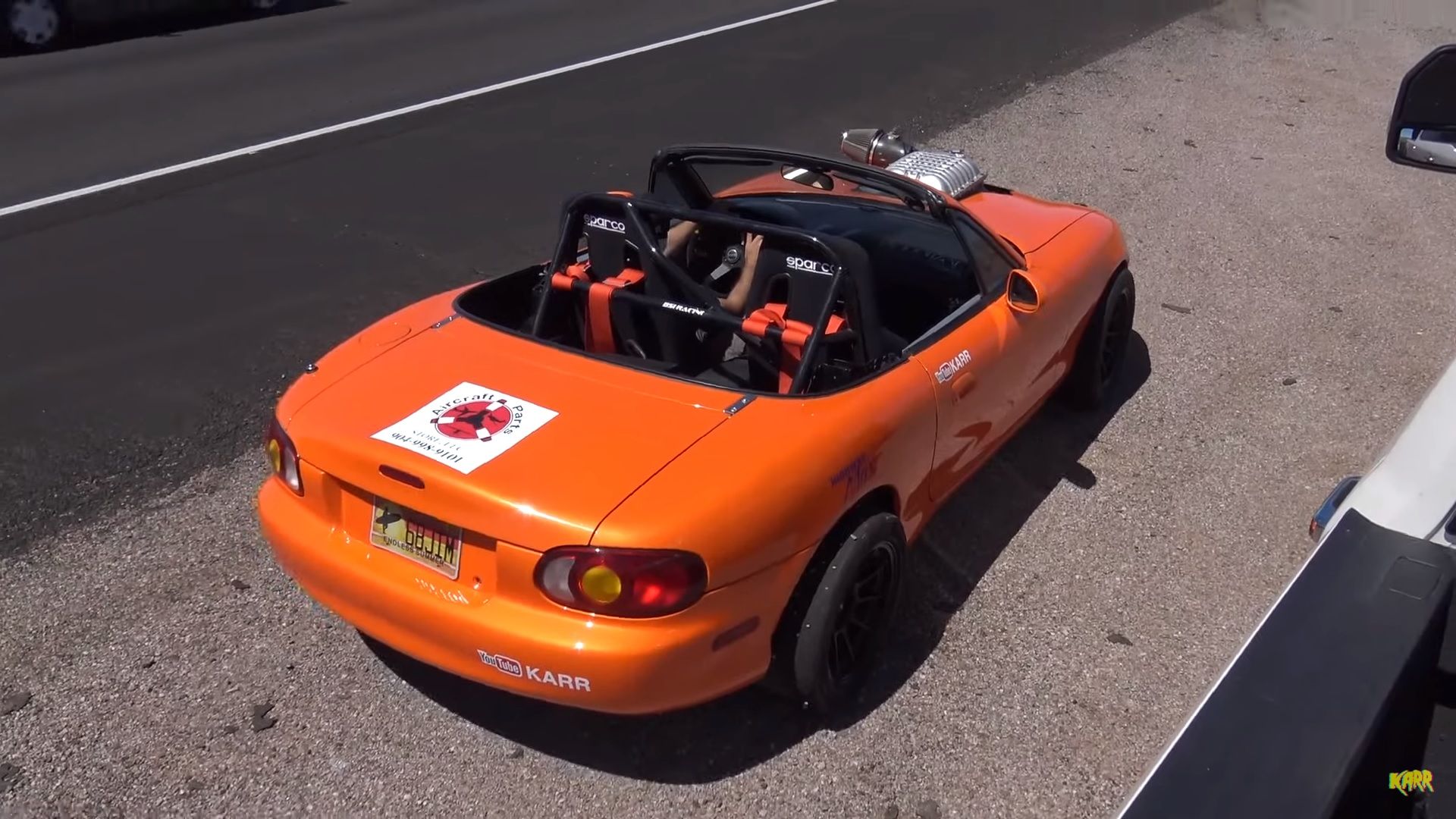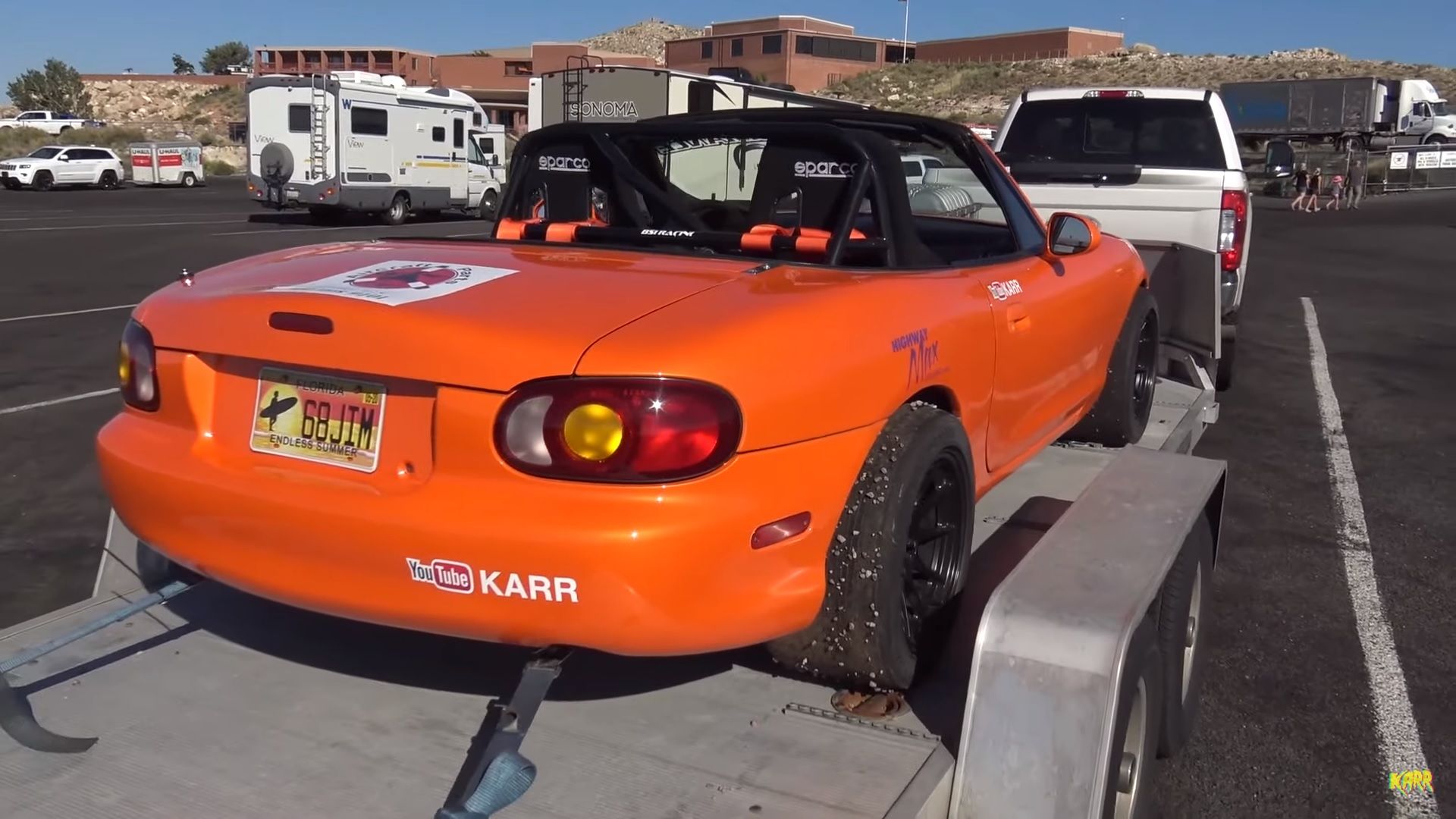Engine swapping is common practice in the world of automotive tuning. If you're inventive enough and your pockets are adequately deep, the sky is the limit when it comes to taking one engine and shoving it in the engine bay of another car. While some swaps make more sense than others, those that really grab our attention are those that, on paper, shouldn't work. That's why this particular 1999 Mazda Miata NB helped our eyebrows reach skyscraper heights. What you see piercing through the hood of the diminutive Japanese sports car is none other than the impressive 6.2-liter Hemi V-8 engine that you'd expect to find nestled in a Dodge Hellcat. All of its 683 horsepower is there and you can own it as it's heading for auction, crossing the block in just a few days during Barrett-Jackson's Las Vegas sale scheduled for October 3-5.
If you're looking at ways to improve the performance characteristics of your car without mortgaging your house in the process, an engine swap may be an attractive solution if you're in need of ponies. Say you've got an NB-generation Miata, the one that forgoes the pop-up headlights and, in turn, comes with ABS as an optional extra. The car is light, handles as well as your shoe and it's loads of fun. But you want more power. You'll soon find out that many people are like you and, while a chunk go for the LS swap (or even the 13B rotary options), you want something else. This car is something else.
Looking at this Miata you can either ask yourself 'Why?' or 'Why not?'
Were it not for the oversized black rims hugged by chunky tires that try to escape the Miata's wheel arches, as well as the sawed hood that was modified to make way for the much taller engine, you could say this is just your average Miata. It's painted orange, similar to the special 30th-anniversary model, to help it stand out a little bit more from a sea of white, black, and grey cars.
The 1.6-liter engine became, when the NB Miata was introduced, a Japan/Europe-exclusive. The B6-ZE mated to a five-speed manual (the 1.8-liter BP-Z3 could also be coupled with a six-speed manual) put out just 108 horsepower 6,500 rpm and a mere 99 pound-feet of twist at 5,000 rpm. There was also the BP-5A 1.8-liter mill that was, in turn, only available in Japan and, finally, the Mazdaspeed Miata featured a turbocharged version of the BP-4W 1.8-liter inline-four (a single IHI RHF5 VJ35 turbocharger with an air-to-air intercooler in the front) that cranked out 178 horsepower at 6,000 rpm and 167 pound-feet of torque at 4,500 rpm. 0-60 mph was achieved in under seven seconds in a Mazdaspeed Miata from '04-'05 and this was respectable at the time but the top speed was still lackluster at just 127 mph.
So, in retrospect, the Miata was never a powerhouse from the factory. The NB penned by Tom Matano was tame-looking with its rounded headlamps and friendly, smiling mouth in the front and this unthreatening character was underlined by what was under the hood. To put it into perspective, a 2004 Honda Civic Si with its 2.0-liter naturally aspirated engine delivered 160 horsepower at 6,500 rpm and 132 pound-feet of torque at 5,000 rpm.
Sure, the Miata was designed to make you grin like an idiot while devouring corners on a twisty B-road, not for highway pulls or tarmac-breaking runs at the drag strip but you can understand why so many want a more powerful Miata. Because you can't help but wonder what an already fun chassis can do when tasked with coping with more oomph.
We talked late last year about a V-8-swapped Miata we found on Craigslist with a sub-$20,000 asking price and a huge bulging hood and 'Monster' in its name. It was said to be able to do low 11-second quarter-mile runs thanks to its Ford Cleveland V-8 stroked from 5.8-liters all the way to 6.7-liters. While it was unclear how much power this meant the NA Miata had to work with, it was clear that 500 horsepower was a conservative estimation. The big talking point surrounding that build was that it could run Dodge Challenger Hellcat times at the drag strip due to how light it was. Well, if you want a Miata that's actually powered by that Hellcat engine, here's one.
The 6.2-liter Hemi V-8 made famous by its usage in the Dodge Challenger Hellcat is a destroked version of the 6.4-liter Hemi V-8 that would develop either 500 horsepower or 707 horsepower depending what key fob you choose: the black one for the so-called street mode and the red one for when you want all of the horsepower at the ready under your right foot. With an IHI supercharger (with a 2.38-liter blower) and an integrated electronic bypass valve to regulate boost pressure, the Hellcat V-8 features an Air Catcher inlet port that connects to an eight-liter airbox. At the time of its release, the 3.62-inch throttle body was the biggest to be found on any Dodge/Chrysler model.
So, is this a 707-horsepower Miata? Yes.
From the outside, the Tangelo Orange sports car looks broadly stock. The front bumper was retained, although there's now a huge intercooler peeking through the inlet in the front as well as no fog lights. On top of that, circular holes have been cut into the sides of the bumper for the exhaust to exit just under the indicators. Other than that, everything's been retained, even the stock side skirts. Of course, the standard 14-inch alloys had to go and were replaced by black Konig 15-inch rims.
Inside, the standard seats were dumped and a pair of Sparco bucket seats with orange harnesses has been fitted in their place, the harness firmly attached to the BSI roll-cage. A Sparco steering wheel greets the driver and, in the middle of the dash, there's an AEM CD5 display. If you're brave enough, you can drive the car, nicknamed the 'Hell Kitty' online, in the rain as it comes with a new Treasure Coast Miata hardtop.
KARR, who built the car, posted a number of videos of the Miata on YouTube like the one above where you can see it roaring and doing burnouts and donuts. The 'Hell Kitty' was also featured on Hoonigan's Daily Transmission and by Gas Monkey's Garage.
We don't know how much this Miata will fetch but remember that the Ford Cleveland V-8-swapped Miata cost in the region of $20,000, but prices on engine-swapped Mazdas vary a lot depending on how much been put in the car (how many other things have been changed besides the engine itself to cope with the swap). There is, for instance, the +$51,000 'Turbo Smurf' NA Miata and that only comes with 210 horsepower and 212 pound-feet of torque from a modified 1.8-liter Mazdaspeed Miata engine with an FM II turbo system. Then there's 'Flyin Miata' that'll build you a turn-key LS3-swapped ND Miata for over $82,000 that boasts a new interior besides the 525 horsepower you expect to be rewarded with courtesy of the 6.2-liter V-8 engine.
What's clear is that this car will turn heads. Remember when we compiled a list of cars that deserve a Hellephant swap? We think we should add the Miata in there after seeing what a Hellcat-swapped example can do. The Hellephant develops 1,000 horsepower and this means you're looking at spending quite a bit of time making the Miata's chassis stiffer - especially if you start off with an older example - but we think it'd be cool to see it happen if that behemoth could fit.
Of course, there are many that view engine swapping as some sort of heresy - putting engines in cars that were never meant for them but we think that, if the job's done right, it deserves to receive praise because no engine swap is as straightforward as it may seem. What's certain is that after all's said and done, you end up with a seriously fun car. Like that 944 with a thumping LS heart in the front or the Honda N600 Hoonitruck with its Suzuki GSXR-1000 engine.
Further reading
|
|
link=art184432> |
Eight Diesel Engine Swaps That'll Surprise You
|
|
link=art174267> |
Check Out This Plymouth Pick Up Truck Featuring An Engine From A Cessna
|
|
link=art170628> |
Read our driven review on the 1990 Mazda MX-5 Miata.
|
|
link=art165034> |
Read our driven review on the 1990 Mazda MX-5 Miata "Turbo Smurf" by Flyin’ Miata.


